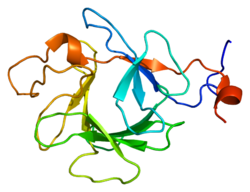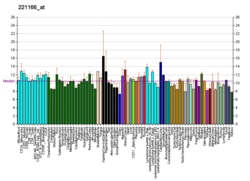Facteur 23 de croissance du fibroblaste
FGF23 est une protéine appartenant à la famille des facteurs de croissances des fibroblastes (« fibroblast growth factor 23 »). Son gène est FGF23 situé sur le chromosome 12 humain.
Rôles[modifier | modifier le code]
Il est exprimé dans les ostéocytes. Il diminue l'expression de plusieurs enzymes intervenant dans la synthèse de la vitamine D[5] , il est très précocement augmenté lorsque les taux sanguins de phosphates[6] sont élevés. Il diminue la réabsorption des phosphates urinaires par le rein[7].
Il pourrait avoir un rôle dans la constitution d'une hypertrophie ventriculaire gauche[8], possiblement par le biais d'une augmentation du calcium intra-cellulaire[9]. Cet effet semble cependant faible[10].
En médecine[modifier | modifier le code]
Son taux est abaissé dans plusieurs maladies comportant une hypophosphatémie dont l'hypophosphatémie liée au chromosome X, l'ostéomalacie tumorale et la dysplasie fibreuse[11].
Son taux peut être augmenté en cas d'hyperphosphatémie, avec augmentation de la synthèse de la vitamine D, calcifications du tissu mou et hyperostose[12].
Le burosumab est un anticorps monoclonal dirigé contre le FGF23 testé dans l'hypophosphatémie liée au chromosome X[13].
Utilisation en tant que marqueur de risque[modifier | modifier le code]
La concentration sanguine en FGF23 augmente en cas d'insuffisance rénale[6] et son taux est corrélé avec la masse du ventricule gauche cardiaque[14],[15]. Il semble être un marqueur de risque de mortalité chez les patients en insuffisance rénale chronique dialysée[16] et de risque d'aggravation de l'insuffisance rénale chez les patients porteur d'une insuffisance rénale modérée[17].
Chez le patient coronarien, un taux élevé semble être corrélé avec un plus grand risque de survenue de maladies cardio-vasculaires et de mortalité[18].
Chez le tout-venant, il semble être un marqueur de risque de dysfonction cardiaque et de survenue de fibrillation auriculaire[19],[20].
Notes et références[modifier | modifier le code]
- GRCh38: Ensembl release 89: ENSG00000118972 - Ensembl, May 2017
- GRCm38: Ensembl release 89: ENSMUSG00000000182 - Ensembl, May 2017
- « Publications PubMed pour l'Homme », sur National Center for Biotechnology Information, U.S. National Library of Medicine
- « Publications PubMed pour la Souris », sur National Center for Biotechnology Information, U.S. National Library of Medicine
- (en) Shimada T, Hasegawa H, Yamazaki Y. et al. « FGF‐23 is a potent regulator of vitamin D metabolism and phosphate homeostasis » J Bone Miner Res. 2004;19:429-35.
- (en) Larsson T, Nisbeth U, Ljunggren O, Juppner H, Jonsson KB. « Circulating concentration of FGF‐23 increases as renal function declines in patients with chronic kidney disease, but does not change in response to variation in phosphate intake in healthy volunteers » Kidney Int. 2003;64:2272-9.
- (en) Gattineni J, Bates C, Twombley K. et al. « FGF23 decreases renal NaPi-2a and NaPi-2c expression and induces hypophosphatemia in vivo predominantly via FGF receptor 1 » Am J Physiol Renal Physiol. 2009;297:F282–F291.
- (en) Faul C, Amaral AP, Oskouei B. et al. « FGF23 induces left ventricular hypertrophy » J Clin Invest. 2011;121:4393-408.
- (en) Touchberry CD, Green TM, Tchikrizov V. et al. FGF23 is a novel regulator of intracellular calcium and cardiac contractility in addition to cardiac hypertrophy Am J Physiol Endocrinol Metab. 2013;304:E863.
- (en) Agarwal I, Ide N, Ix JH. et al. « Fibroblast Growth Factor–23 and cardiac structure and function » J Am Heart Assoc. 2014;3:e000584.
- (en) Imel EA, Econs MJ. « Fibroblast growth factor 23: roles in health and disease » J Am Soc Nephrol. 2005;16:2565–75.
- (en) Liu S, Quarles LD. « How fibroblast growth factor 23 works » J Am Soc Nephrol. 2007;18:1637–47.
- Carpenter TO, Whyte MP, Imel EA et al. Burosumab therapy in children with X-linked hypophosphatemia, N Engl J Med, 2018;378:1987-1998
- (en)Gutierrez OM, Januzzi JL, Isakova T. et al. « Fibroblast growth factor 23 and left ventricular hypertrophy in chronic kidney disease » Circulation 2009;119:2545-52.
- (en) Mirza MA, Larsson A, Melhus H, Lind L, Larsson TE. « Serum intact FGF23 associate with left ventricular mass, hypertrophy and geometry in an elderly population » Atherosclerosis 2009;207:546-51.
- (en) Gutierrez OM, Mannstadt M, Isakova T. et al. « Fibroblast growth factor 23 and mortality among patients undergoing hemodialysis » N Engl J Med. 2008;359:584-92.
- (en) Isakova T, Xie H, Yang W. et al. « Fibroblast growth factor 23 and risks of mortality and end‐stage renal disease in patients with chronic kidney disease » JAMA 2011;305:2432-9.
- (en) Parker BD, Schurgers LJ, Brandenburg VM. et al. « The associations of fibroblast growth factor 23 and uncarboxylated matrix Gla protein with mortality in coronary artery disease: the Heart and Soul Study » Ann Intern Med. 2010;152:640-8.
- (en) Seiler S, Cremers B, Rebling NM. et al. « The phosphatonin fibroblast growth factor 23 links calcium‐phosphate metabolism with left‐ventricular dysfunction and atrial fibrillation » Eur Heart J. 2011;32:2688-96.
- Mathew JS, Sachs MC, Patton KK et al. Fibroblast growth factor-23 and incident atrial fibrillation: the Multi-Ethnic Study of Atherosclerosis (MESA) and the Cardiovascular Health Study (CHS), Circulation, 2014;130:298–307






